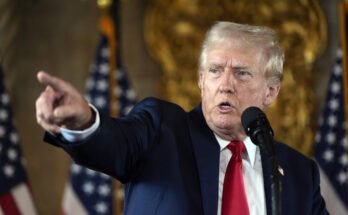[ad_1]
With inflation almost defeated and the cooling labor market, the Federal Reserve is ready to start cutting its key interest rate from its current 23-year high, Chairman Jerome Powell said on Friday.
Powell did not say when the rate cuts would begin or how big they might be, but the Fed is widely expected to announce a modest quarter-point cut in its benchmark rate when it meets in mid-September.
“The time has come for policy to adjust,” Powell said in his keynote speech at the Fed’s annual economic conference in Jackson Hole, Wyoming. “The direction of travel is clear, and the timing and pace of rate cuts will depend on incoming data. , the evolving outlook, and the balance of risks.”
His reference to multiple tax cuts was the only hint that a series of reductions is likely, as economists have predicted. Powell emphasized that inflation, after the worst price spike in four decades has inflicted pain on millions of families, it seems. largely under control: :
“My confidence has grown,” he said, “that inflation is on a sustainable path back to 2%.”
According to the Fed’s preferred measure, inflation fell to 2.5% last month, well below its peak of 7.1% two years ago and only slightly above the 2% target level of the central bank.
The Fed chair also said that rate cuts should keep the economy growing and support hiring, which slowed last month. Continued growth could boost Vice President Kamala Harris’ presidential campaign, even as most Americans say they are dissatisfied with the economic record of the Biden-Harris administration, especially as average prices remain well above where they were before the pandemic.
“We will do everything we can,” Powell said, “to support a strong labor market as we make further progress toward price stability.”
By cutting rates, he said, “there is good reason to think the economy will return to 2% inflation while maintaining a strong labor market.”
A rate cut in mid-September, which comes less than two months before the presidential election, could bring some unwanted political heat on the Fed, which is trying to avoid getting entangled in election-year politics. Former President Donald Trump argued that the Fed should not cut rates so close to the election. But Powell repeatedly stressed that the central bank would make its rate decisions based only on economic data, without considering the political calendar.
In what was a victory statement, Powell noted in his speech on Friday that the Fed had succeeded in conquering high inflation without causing a recession or a sharp increase in the unemployment rate, which many economists had long predicted.
The Fed chair attributed that result to the disruption of the pandemic to supply chains and labor markets, and a reduction in job vacancies, which made it possible to cool down wage growth .
After the government said this month that hiring in July was much less than expected and the unemployment rate reached 4.3%the highest in three years, stock prices plunged for two days on fears that the United States could fall into a recession. Some economists began to speculate on a Fed rate cut of half a point in September and perhaps another identical cut in November.
But the most healthy economic reports last week, including another decrease in inflation and a robust gain in retail salesin part dispelled these concerns. Wall Street traders now expect the Fed to cut its benchmark rate by a quarter point in September and November and by half a point in December. Mortgage rates have already started to drop in anticipation of rate cuts.
A half-point Fed rate cut in September would become more likely if there were signs of a further slowdown in hiring, some officials said.
Campaign Action


